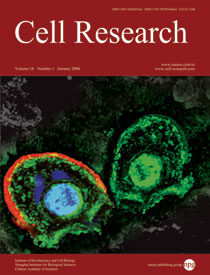
Volume 16, No 1, Jan 2006
ISSN: 1001-0602
EISSN: 1748-7838 2018
impact factor 17.848*
(Clarivate Analytics, 2019)
Volume 16 Issue 1, January 2006: 82-92
ORIGINAL ARTICLES
Blocking of N-acetylglucosaminyltransferase V induces cellular endoplasmic reticulum stress in human hepatocarcinoma 7721 cells
Huan Fang1, *, Wei Huang2, *, Ying Ying Xu1, *, Zong Hou Shen1, Chao Qun Wu2, Shou Yi Qiao2, Yan Xu2, Long Yu2, Hui Li Chen1
1State Key Laboratory of Genetic Engineering, Department of Biochemistry, Shanghai Medical College, Fudan University, 138 Yi Xue Yuan Road, Shanghai 200032, China;
2Department of Genetics, School of Life Science, Fudan University, 220 Handan Road, Shanghai 200433, China
Correspondence: Zong Hou Shen, Chao Qun Wu(zhshen@shmu.edu.cn cqwu@fudan.edu.cn)
N-acetylglucosaminyltransferase V(GnT-V)is an important tumorigenesis and metastasis-associated enzyme. To study its biofunction, the GnT-V stably suppressed cell line (GnT-V-AS/7721) was constructed from 7721 hepatocarcinoma cells in previous study. In this study, cDNA array gene expression profiles were compared between GnT-V-AS/7721 and parental 7721 cells. The data indicated that GnT-V-AS/7721 showed a characteristic expression pattern consistent with the ER stress. The molecular mechanism of the ER stress was explored in GnT-V-AS/7721 by the analysis on key molecules in both two unfolded protein response (UPR) pathways. For ATF6 and Ire1/XBP-1 pathway, it was evidenced by the up-regulation of BIP at mRNA and protein level, and the appearance of the spliced form of XBP-1. As for PERK/eIF2α pathway, the activation of ER eIF2α kinase PERK was observed. To confirm the results from GnT-V-AS/7721 cells, the key molecules in the UPR were examined again in 7721 cells interfered with the GnT-V by the specific RNAi treatment. The results were similar with those from GnT-V-AS/7721, indicating that blocking of GnT-V can specifically activate ER stress in 7721 cells. Rate of
3H-Man incorporation corrected with rate of
3H-Leu incorporation in GnT-V-AS/7721 was down-regulated greatly compared with the control, which demonstrated the deficient function of the enzyme synthesizing N-glycans after GnT-V blocking. Moreover, the faster migrating form of chaperone GRP94 associated with the underglycosylation, and the extensively changed N-glycans structures of intracellular glycoproteins were also detected in GnT-V-AS/7721. These results supported the mechanism that blocking of GnT-V expression impaired functions of chaperones and N-glycan-synthesizing enzymes, which caused UPR
in vivo.
Cell Research (2006) 16:82-92. doi:10.1038/sj.cr.7310011; published online 16 January 2006
FULL TEXT | PDF
Browse 2217


